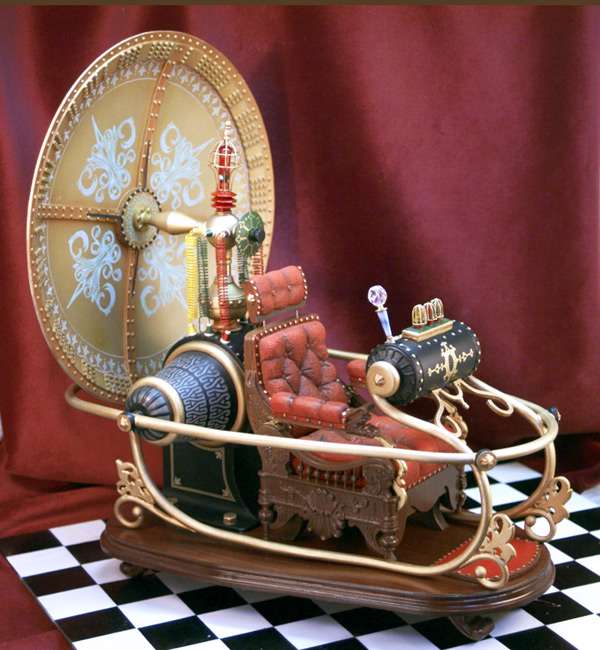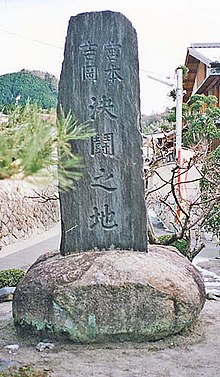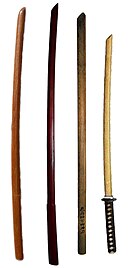Kaoko: We're going to learn about samurai this time, we'll meet one of renowned Japanese swordsmen. Kedo, toshookan ni ikanai desu yo (but we're not going to the library), we'll go to the year where the history takes place!
Tna: Sou, sou (You're right). We're going to 370 years ago by time machine ! Ikoo (let's go), Kaoko-chan!
Kaoko: Iku yoo~
Chiba Castle, Kumamoto Prefecture
Japan, 1641
Kaoko: Gyah~ what a tiring journey!
Tna: Guess so... but don't you realize, Kaoko-chan? The air is soooo refreshing!~
Kaoko: Yeah, your right... c'mon Tna-chan, we have to look for Musashi-san inside this castle promptly!
Tna: Are you sure he's here? Wait, wait, how can we go inside the castle without being discovered by the guards?
Kaoko: Shinpai shinai yo (don't worry)... Hirashin no Jutsu!
*PUFF*
Tna: Where are we?
Kaoko: Inside the castle. Don't worry, I've found Musashi-san room. Ikoo, Tna-chan, hayaku~
Tna: Chotto, chotto (wait, wait)... saki ni nanka jutsu wo tsukatta no? (what kind of technique did you use before?)... Masaka, did you use 'Teleportation Jutsu?"
Kaoko: Sono toori desu!~ (exactly!)
Tna: Nande nande jutsu wo tsukatte ni dekiru na no? Ninja ja nai no ka anata? (Why why you could use such jutsu? You're not a ninja right?)
Kaoko: Ohoho~ Actually, I once entered the fourth hokage room and read one scroll about teleportation technique

Tna: Ah sou ka
 Let's go!
Let's go!Kaoko: Sumimasen, Musashi-san... Watakushi wa Kaoko desu, nakama to koko ni kita. Watashitachi ga kuru kamo shirenai? (Excuse me, Musashi-san... I am Kaoko, I'm coming here with my friend. May we enter the room?)
Musashi: Hai, douzo. (Yes, go ahead.)
Tna: Watakushi wa Tna desu. Yoroshiku onegaishimasu

Musashi: Yoroshiku

Kaoko: Musashi-san, jitsu wa... (actually...)
Tna: Chotto, Kaoko. I think we should use this translator device...
Kaoko: Oh sou ne~
*convert to English*
Kaoko: Musashi-san, actually we're coming from the future to ask you some assistance about our today's lesson in Japanese Classroom...
Tna: Nah, we're going to study about Japanese history, so we came here... everyone knows that you are one of those well-known swordsman in Japanese legend...
Musashi: You're coming from the future? What kind of non-sense were you talking about?
Kaoko: Gomen, Musashi-san... You may not believe, but we really need your help this time.
Tna: Yeah, onegaishimasu~

Musashi:
 Maa ii... What can I do to help you?
Maa ii... What can I do to help you?Tna: We want to know about your life stories until now... sorry for trouble you.
Kaoko: You don't need to tell specifically... pretty please?

Musashi: Well, well, okay. I'm not really good at sharing my life stories but I'll tell you anyway. I become famous under the name Miyamoto Musashi (宮本武蔵), taken from a warrior monk named Musashiro Benkei. But actually my real name is Shinmen Takezoo, which has the same kanji but different pronunciation. I was born in 1584 in Banshuu (Harima Province)...
Musashi: My childhood name is Bennosuke (弁之助). I'm the son of Shinmen Munisai who divorced my mother, Yoshiko, not too long after I was born. My father then remarried. When I was 7, I lived with my uncle, Dorin, in Shoreian temple, three kilometers (~1.8 mi.) from Hirafuku, as a Buddhist. I learnt about Buddhism and basic skill such as writing and reading...
Musashi: At the age of thirteen, I fought my first duel. My opponent was called Arima Kihei, a sword adept of the Shinto ryuu, I defeated him. Kihei attacked with a wakizashi (a traditional Japanese sword with a blade between 30 and 60 cm, with an average of 46 cm), but I threw him on the floor and when he tried to get up, I struck him between the eyes and beat him to death...
Tna: Wah, hidoi~ you already began your battle at the age of 13? Shinjirarenai~
Musashi: Yeah, because we're a Samurai, so we should prepare ourselves to enter the duel anytime, even at the very young age.
Kaoko: Then, what did you do after winning the battle back then?
Musashi: Three years later afterwards, I left the village. I spent time for travelling and engaging in duels, such as with an adept called Akiyama from Tajima Province. In 1600, a war began between Toyotomi and Tokugawa clans. I fought on the side of the Totoyomi's "Army of the West, as the Shinmen clan had allied with them. Specifically, I participated in the attempt to take Fushimi castle by assault in July 1600, in the defense of the besieged Gifu Castle in August of the same year, and finally in the Battle of Sekigahara. Unfortunately, Totoyomi side lost and I fled as well and spent some time training on Mount Hiko (between Fukuoka Prefecture and Ooita Prefecture in Kyushu)...
Musashi: ... I disappeared from the records for a while. When I was 20, I arrived in Kyoto and began a series of duels against Yoshioka clans. First, I challenged Yoshioka Seijurō and agreed to a duel outside Rendaiji in Rakuhoku, in the northern part of Kyoto on March 1604. I defeated him, but then his brother, Yoshioka Denshichirō, challenged me for revenge. I defeated him as well. Another Yoshioka family, a 12-year-old Yoshioka Matashichiro, also challenged me to a duel outside the Kyoto, near the Ichijoji Temple. Usually, I had a bad habit of coming late when I was about to duel, but that time I broke it. I came to the temple hours early. Hidden, I assaulted the Yoshioka force, killing Matasachiro, and escaping.
Tna: Where did you leave that time?
Musashi: I traveled to Hōzōin in Nara, to duel with and learn from the monks there, widely known as experts with lance weapons. There I settled down at Enkoji Temple in Banshu and taught the head monk. From 1605 to 1612, I traveled extensively all over Japan in Musha Shugyo. I used bokken (Japanese wooden sword used for training, usually the size and shape of a katana, but sometimes shaped like other swords) in actual duels. Most of the engagements from these times did not try to take the opponent's life unless both agreed. I didn't care which weapon my foe used.
Various kinds of Bokken
Musashi: During that time, I fought and fought, got into one duel to another duel. In 1611, I began practicing zazen meditation. On April 13, 1612, I fought my duel with Sasaki Kojirō, who was known as "The Demon of the Western Provinces" and who wielded a nodachi. As usual, I came late and unkempt to the appointed place — the island of Funajima, in the Kanmon Straits separating Honshu and Kyushu. The duel was short, I killed his opponent with a bokken. At the same year, I established a fencing school.
Kaoko: And then you still got in duel and duel?
Musashi: Of course. In 1614-1615, again I participated in the war between the Toyotomi and the Tokugawa. The war had broken out because Tokugawa Ieyasu saw the Toyotomi family as a threat to his rule of Japan. Still I fought on Totoyomi's side. Osaka Castle was the central place of battle. The first battle ended in truce, but the second resulted in the total defeat of Totoyomi. But in the end, I successfully defeated Ieyasu, yeah even he was in poor health already in his 70's...
Tna: I can't stop wondering why Totoyomi and Tokugawa clans always fought each other...
Kaoko: Sou... why didn't they take such a peaceful way instead of war?
Musashi: Maybe because you both are coming from the future, so you have no idea about the ancient people styles when solving the problem. We gained peace by war, indeed. Well, I'll continue. In 1615 to 1621, I came into the service of Ogasawara Tadano in Harima province as a construction supervisor. I helped construct Akashi Castle and in 1621 to lay out the organization of the town of Himeji. I also taught martial arts during my stay, specializing in instruction in the art of shuriken-throwing. During this period of service, I adopted a son named Miyamoto Mikinosuke. Then, in 1622, I set up temporary residence at the castle town of Himeji in Hyoogo Prefecture. A year later, I traveled to Edo and adopted a second son named Iori - Miyamoto Iori. Me and Iori then stopped at Osaka while Mikinosuke became a vassal to the Himeji domain...
Tna: Then what happened to Mikinosuke-san while he was separated from you and his step brother?
Musashi: My first adopted son commited seppuku (stomach cutting - a form of Japanese ritual suicide by disembowelment) in 1626 following the tradition of Junshi, because the death of his lord. I began to travel again a year after with Iori. Seven years later in 1633, I began staying with Hosokawa Tadatoshi, daimyo (the powerful territorial lords) of Kumamoto Castle, who had moved to the Kumamoto fief and Kokura, to train and paint. A year later me and Iori settled in Kokura, Fukuoka Prefecture for a short time as a guest of Ogasawara Tadazane. In 1640, I officially became the retainer of the Hosokowa lords of Kumamoto in 1640 and lived in Chiba Castle, Kumamoto Prefecture until now. I'm currently writing Hyoho Sanju-go...
Kaoko: Oh, such a long long journey... it's not easy being a samurai after all...
Tna: You're right. Then Hyoho Sanju-go tells about what?
Musashi: It's about thirty-five instructions of strategy in war, especially for samurai. I'll try to finish this book this year...
Kaoko: Sou desu ka. Tonikaku (by the way), hontou ni arigatou, Masashi-san... you really help us a lot... 

Tna: Arigatou gozaimasu  . We're excused now, Musashi-san...
. We're excused now, Musashi-san...
 . We're excused now, Musashi-san...
. We're excused now, Musashi-san...Musashi: Dou itashimashite (you're welcome). Anytime  . How do you come back to the future?
. How do you come back to the future?
 . How do you come back to the future?
. How do you come back to the future?Kaoko: By time machine. We left it outside the castle.
Tna: Ja, sayonara! Shitsureishimasu!~ (See you later! Excuse me!~)
May 24, 2011
Tna: Gyah~ Finally we're back...
Kaoko: Tna-chan, the story hasn't ended yet... we should tell the rest...
Tna: Ah, sou, sou. Well, a year later after the time we visited Musashi-san, he suffered from neuralgia, foreshadowing his future ill-health. How sad... 

Kaoko: Then in 1643, he retired to a cave named Reigando. He lived as a hermit and wrote Go Rin No Sho (The Book of Five Rings), the overlapping work of Hyoho Sanju-go. He finished it in February 1645... sadly, he died in the same year, in June 13, 1645, also in Reigando Cave 

Tna: Commiserate for Musashi-san  . He's truly a samurai legend...
. He's truly a samurai legend...
 . He's truly a samurai legend...
. He's truly a samurai legend...Kaoko: Yeah 

Nga: *cough* By the way, what's the Go Rin No Sho about?
Tna, Kaoko: Nga-chan?  Koko ni itsu kara (since when were you here)?
Koko ni itsu kara (since when were you here)?
 Koko ni itsu kara (since when were you here)?
Koko ni itsu kara (since when were you here)?Nga: Since you two were about to travelling to the past by the time machine and you didn't ask me to join while the idea of inviting Musashi-san came from me. How mean... 

Tna: Gomen, gomen, Nga-chan... we didn't realize that you were here back then 

Kaoko: Hai, atashi mo (yeah, me too)... 

Nga: Mou ii (It's okay). Now please tell me about that book.
Tna: Hai, hai. The book is about kenjutsu (the technique of sword) and the martial arts. It's considered a classic treatise on military strategy, much like Sun Tzu's The Art of War (such Fuurinkazan)...
Kaoko: Musashi describes and advocates a two-sword style (nitōjutsu): that is, wielding both katana and wakizashi, contrary to the more traditional method of wielding the katana two-handed. However, he only explicitly describes wielding two swords in a section on fighting against many adversaries...
Tna: As for the further details of the book, we may explain later... Dou (how), Nga-chan?
Nga: Hai, hai, sukoshi na wakaru yo~ (Yeah, yeah, I understand a little bit)
Kaoko: Maa, that's our today's lesson. May we help you understand a little bit about Musashi's life story.
Tna, Kaoko, Nga: Ja minna, tsugi no jugyoo o sanshoo shite kudasai~ (well everyone, see you on the next lesson!)








:D Thanks a bunch! This is just amazing, to appear in your lessons anf be by your side. *ahem*
ReplyDelete-You popped up a brilliant idea, to begin with. Speaking about Japan, we can't help but think about samurai, and concerning great samurai(s) ... here we go Miyamoto Musashi-san! :D If I'm not mistaken, the "Miyamoto" is a popular surname in Japan, too (perhaps not that many as "Suzuki" :D) I have read quite a lot of him, but you still managed to bring me new, interesting and helpful information, believe me. (I'll tell in details later) As I stated, "Amakusa1637" is a manga based on history, thoug it changed some certain features. Miyamoto-san was awesome there, and was ver nice-looking :D. However he's not the main character. As expected from shoujo, the story invented some beautiful women around him and his affairs with them lol. Another manga featured Miyamoto-san is *thinks thinks thinks* "Musashi". That was a tough shounen to read, but it's interesting and intriguing at the same time, I admit. If you're under 18, you should not read it now, just in case you care enough to read it.
-Miyamoto-san led a typical life of a samurai, didn’t he? Duels, swords and deaths and everything related to a decent swordman. The fact that he had his 1st duel at the age of 13 didn’t surprise me though:He WAS a samurai, and a great one. I remember a phrase like this from the author of “Kaze Hikaru” commented on the day Seizaburo Kamiya killed for the 1st time “Children at the age of 13, 14 had to kill people without mercy … that’s how this period in our history is characterized” (that story happened later, though, the timeline is a bit different, but still)
ReplyDelete*reads the rest* The war between 2 most powerful clans in ancient history of Japanese is mentioned in various shounen manga which featured martial-arts, I read several of them but "Kyo" is the only one who survived in my pity memory :D. There were soooo many skillful samurai(s) in such a stormy period of time, ne? And if I'm not mistaken, the Japanese serial drama so-called "Amizu" is a story based on this war (random: Oguri Shun a.k.a Kudo Shinichi live action season 1 and 2 's actor was a supporting role there, lol)
ReplyDelete*ahem* and it’s time for my disease, i.e randomness. Hyoho Sanju-go, that reminds me of Furinkaazan lol. I’m interested in war strategies, just to inform you. I used to learn by heart “Three Kingdom”, and enjoyed reading “The ravages of time” by Chanmou (the translated version, of course). NOT now. I forgot a lot.
Samurai(s) don’t tend to live long, ne? As you mentioned, one of Miyamoto-san’s adopted son had committed seppsuku because his lord passed away. I read an article somewhere before which wrote about “bushido” (literally means “the path of a swordman”). There was a phrase which sounds like this “being afraid of death is worse than death itself” “don’t think about it – do it. Die and your noble spirit is preserved forever.” In the “Kaze Hikaru” by Watanabe Taeko I kept babbling about, a samurai thought this way when he watched the sakura petals fly “A sakura’s life is similar to a samurai’s. Too short to regret anything”.
ReplyDeleteThanks for the information of "two-swords" style! So it IS by the famous Miyamoto Musashi :D Sugoi ne (although at first one could mistake it for "each hand a sword" style lol.)BTW is the word "ni" in "nitoujutsu" means "2"? :D I heard somewhere "ni gatsu" means "February". Correct me onegaishimasu. I like this Jap. expression the most today lol "sukoshi na wakaru yo". Arigato, that was a great treat. Keep fighting! (Yeah I'm done, you can rest now)
ReplyDelete*cough*... still... *cough* speechless! You indeed knew much about samurai, sugoooi~ while I only read Samurai X T.T
ReplyDeleteWhat's that shoujo manga about? Don't worry, I'm 22 ;p
Well, actually when wrote the story, I was bit confused. There are so many versions of Masashi in battle, also about the year he was born. Some source told he born in 1583, but the rest said 1584, and so did about the battle.
Yeah, 'ni' means two, and nigatsu is february because ni=2, and gatsu= month :P
Thaanks so much for reading and the review xD